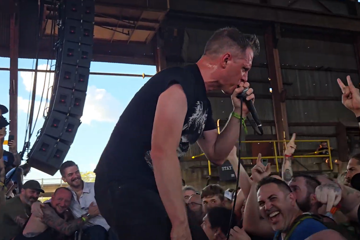Live Music Recovery - Is Australia Being Left Behind?
As Australia grapples with the fallout from its latest COVID-19 surge, how does our map to live music recovery stack up against the rest of the world?
Like a nightmarish version of the 1993 Bill Murray classic Groundhog Day, the most recent string of snap COVID-19-induced lockdowns and dawdling vaccination rates across the country has seen Australia swiftly transition almost overnight from being a leader in the live event recovery movement to an international punchline.
The roadblocks to recovery were always firmly in the sights of venues, event organisers and artists who had spent the better part of 18 months diligently toeing the line of reduced capacities, strict procedures and the looming possibility that the best laid plans may be temporarily postponed; but with the latest COVID flare ups, JobKeeper gone and incessant border restrictions for both local and international acts, the real question must now be asked: can Australia's live event industry actually recover from the latest series of events after already being beyond breaking point?
In just the space of a few short weeks, the real irony of the situation has been soberingly realised, with Australia previously and steadfastly perched as a survivor and a pioneer on the live music front amid the COVID-19 pandemic. Emerging from 2020 remarkedly unscathed on the surface when compared to the rest of the world, our statistics from a cases per capita perspective alone was enough to spark envy overseas as bands and general punters in lockdown watched our live streams of COVID-safe events and performances bandied about, and tour announcements becoming a more frequent and joyous sighting.
For some states in Australia, it had almost been business as usual throughout the pandemic, with many states earning back their dancefloor status at venues far earlier than others, and a confident, firm push from above that "touring was back on". But, just as parts of the country were finally tasting sweet freedom after some punishing stints stuck at home, key happenings like the sudden cancellation of events like Bluesfest just 24 hours from opening its gates all the way to the recent sudden lockdowns imposed around the country have irrevocably jolted the music industry into a sad realisation that not only is live music in Australia being left behind; but it could take months to even return to the tentative state we were recently enjoying, let alone years before pre-COVID freedoms are back in play.
With a disproportionate balance between live shows and sporting events, alongside a raft of ongoing uncertainties, the road to recovery in Australia is certainly a cloudy and mangled highway right now. But just how does Australia currently stack up after the most recent turn of events? We unpack some of the various live event recovery road maps and the general status around the globe, continent by continent, to see how we compare on the world's stage.
--------------
Don't miss a beat with our FREE daily newsletter
EUROPE
Once the poster child for staggering second waves of COVID-19 outbreaks, the European approach to resuming live music events has been an intricate mix of pilot events and firm research.
Since March 2020, European music venues and clubs have been in pure survival mode, with a 70% decline of music events and artist performances. But in incredible sights over the past few days, thousands of heavy metal fans were able to descend on Donington Park in central England for the multi-day pilot Download Festival; one of many test events to ascertain if mass gatherings can take place without causing significant spreading of COVID-19 (and holding the significant honour of being Britain's first full music festival since the coronavirus first came to town).
While the capacity at the recent UK Download Festival was down one-tenth of its pre-pandemic attendance (allowing 10, 000 fans to catch acts like Enter Shikari, Frank Carter & The Rattlesnakes and Bullet For My Valentine onstage), the sight of fans moshing side-by-side sans-face mask seemed like an unthinkable fantasy as Australia plunged most of the country back into lockdown.
The key factors to having an event like Download go ahead in the UK in the current climate?
- All attendees were required to take COVID-19 tests before the event
- Health officials in the UK are driving to give everyone 18 and over a first dose of their COVID-19 vaccine by July 19, with everyone over 50 fully vaccinated with both doses by this time. Whether or not the government can deliver on this promise remains to be seen
Elsewhere in Europe, Northern Ireland plans to have a new vaccine passport available from July, which would radically impact the current live music and outdoor restrictions in the area, while in Spain, a gig in Barcelona back in April experimented with 5,000 fans required to wear masks at a test event, but negating the requirement to social distance.
Europe's road to recovery for live music is one equally embroiled in financial disarray; but with more and more venues opening to reduced capacities, and the plans for ticket-holders to provide proof of health at various events, the prediction is for big tours to be back on the cards in Europe by the end of the year.
NORTH AMERICA
Meanwhile, as areas in North America continue to reopen following significant lockdown periods and the US being ravaged by some of the highest confirmed COVID-19 case rates in the world, as of June 10 this year it was reported that North American countries have vaccinated at least 30% of their citizens - a fact that has seen live music start to crawl back to life, albeit in very different formats.
Trends emerging in North America alongside the slow but ongoing steady return to live events signal tentative steps towards rebuilding the industry, particularly in parts of the US that are opening up, with surveys highlighting significant movement on the touring and festival front, alongside saddening statistics that nearly 90 clubs around the country had permanently closed.
Key shifts to rejuvenating live music, particularly in the United States with their annual Independence Day celebrations just around the corner, have been firmly based on small but steady plans of attack, notably:
- Outdoor and smaller venues back in action, with limited capacities
- A colour-tier rating system ranking levels of COVID crisis, from purple (widespread) to yellow (minimal), allowing California to eliminate all social distancing measures on June 15
- New COVID-19 protocols in place at certain venues: e.g. six feet of space between groups of ticket holders, who will only occupy every other row, and masks required in indoor spaces
- The implementation of touchless payment systems for all transactions at many venues
- Some events providing new vaccine-only policy for concert goers, who can show proof of vaccine using an app and filling out a questionnaire in advance (with the option for those who are not vaccinated to still partake by getting a COVID test in advance or on-site on the day if the event)
While the road map for the US may not be entirely uniform across its various cities and states, one key constant remains: that fans are hungry to get out and see live music again, and this constant continues over to Canada - but here, it's accompanied by uncertainty and frustration over short notice for changes in the live areas.
Late last week, advocates for Ontario's live music and performing arts industries lamented a lack of clarity in the proposed Step 3 plans set to potentially take effect sometime in July, following a sudden instigation of Step 2, with venues given less than a week's notice that concert events could move forward to 25% capacity as of July 30.
For now, many venues and organisers are working towards a tentative date of October 1 for a reopening target in Canada; but whether that date remains tangible remains to be seen.
SOUTH AMERICA
In September 2020, it was predicted that the Latin America region's live music industry would likely suffer a 10-year setback, with countries already strained under social unrest facing a double whammy when COVID-19 hit the regions.
Several territories in Latin America have withstood some of the longest quarantine periods in the world, while still managing to stage some events including the odd concert drive-in able to sneak through; but, as with most areas around the world, the harsh restrictions made carrying out most events financially impossible.
For the music industry, the setbacks largely ripped financially, with a reported 80% of events cancelled or postponed in Brazil alone. And while the local music sectors took the opportunity to internally question its models amongst lengthy lockdowns and seemingly unending hurdles, government responses were uneven across the areas, with an absence of representation in places like Mexico, Columbia and Peru.
Named the world's worst COVID hot spot a month ago, it's interesting to note that while the embattled continent has struggled with industry support and vaccine rollout, ultimately it has balanced opening for the sake of the economy over restricting socialisation and general day-to-day life so slow the spread.
As of last week, Brazil and Mexico have reopened their economies, amid the rising death tolls; an extremely different narrative compared to the one playing out in Australia right now.
ASIA
Going back to the early days of the COVID-19 pandemic, the first widely publicised measures to guard against the growing situation in Asia came in the form of the late January 2020 cancellation of Cantopop star Andy Lau's tour in Hong Kong. What promptly followed was a collapsing house of cards, with other concerts in the region immediately cancelled, and a flow-on effect coursed out across Asia on the live music front, largely centred around freight and travel restrictions.
Swiftly as the pandemic grew and expanded, overseas artists cancelled Asian concert tours, with some simply postponing, but many, including summer festivals, seemingly holding out hope for a quick recovery. That recovery, of course, did not come, and with the main international artist drawcards unable to enter the countries, the live music sector became static.
Back in September last year, things slowly seemed to crawl back to some normality, with the 50% limit on audience capacity in Japan lifted, permitting the sale of close to 100% seats. But overall, Asia's firm government guidelines and resulting live music recovery attempts have been very much one of constant management, and the acceptance that the situation is far from over.
In China, it was also reported in September last year that 2020 was, in fact, a good year for China's digital music business at the time, which also helped open the door to international (albeit distanced and digital) collaborations between artists that may not have emerged if not for the pandemic's restrictions.
As for India, the ongoing limitations continues to cripple the industry, with preventative measures taken over a year ago still impacting the live event industry. Back in March 2020, India suspended visas for nationals from all countries, resulting in visiting DJs, bands and producers scheduled to play in Mumbai falling over instantaneously. And after traversing a horrific deadly outbreak back in April and May this year, it was reported a few weeks ago that India's capital, New Delhi, would ease some coronavirus restrictions, allowing various businesses to reopen with limited hours after the Delta variant ran rampant. As curfews ease and more districts reopen following the spring surge, it's hopeful the burgeoning-yet-stalled music scene will catch a break; but sadly the crisis in India is still very much far from over.
AFRICA
In December last year, it emerged that nearly half the people working in South Africa's live music sector may quit the industry for good. Researchers implemented a study, called Impact Analysis: Live Music and its Venues and the South African Economy During COVID-19 to determine larger trends and numbers, and also curate in-depth information about live music workers' experiences throughout the pandemic. While the findings were unsurprising, the ultimate realisation that emerged was that musicians, promoters and venue owners responded to the crisis swiftly, with over 88% adopting new online music strategies to cope with the ongoing restrictions.
In early 2021, Music In Africa Live was launched, providing African musicians with digital expertise to produce live online concerts, as well as to help enhance digital skills via video tutorials; but these skills alone are, of course, not nearly enough to keep the music industry itself afloat long-term.
But as the third wave of the pandemic is hitting South Africa, the imposed measures to help stop the spread once again has seen artists continue to find ways to reinvent themselves with very little aid from the state to regroup. From photographers documenting the lockdown in a visual series to juggling freelance assignments from various companies, many in South Africa have had to be creative in their adaptation; and many are relishing in the forced opportunity. But despite the hustle and drive of the artists, sadly, according to Deutsche Welle, some key roadblocks for the creative arts in the continent continue to ravage the overall industry, including but not limited to the below:
- Funding in South Africa comes from the Department of Arts and Culture, but, according to reports, how that money is accessed is not transparent
- In the Democratic Republic of Congo, artists are not even funded
The road map in Africa is ultimately riddled with a multitude of internal and external factors; but artists in various parts of the continent are already used to self-financing their creative projects well before COVID ever came knocking, and the arrival and embracing of a more digital modus operandi has benefitted content creators throughout Africa who were already skilled up in those arenas.
--------------
Which brings us to our very own doorstep. Even before the latest COVID outbreaks around Australia, it was reported back in March by the ABC's Paul Donoughue that nearly half of the music industry businesses would not survive the next three months if capacities weren't lifted, and if inroads weren't made to help artists tour nationally, or coax international artists back to our shores. With calls for imminent help and a permit system to potentially help artists and venues work around snap restrictions, ultimately where can we go from here?
While the overarching consensus worldwide is that companies and businesses need to look inward to streamline in order to survive, the revelation in Australia moving from almost being one of the first to stage a festival featuring international acts to sitting squarely in the dark is a difficult and near-impossible pill to swallow.
As the Aussie live event industry sits perched on a knife's edge yet again, the time for waiting and seeing is long passed, and the issue has transcended being merely a local or state crisis. The irrefutable necessity now is for the federal government to step up and take the reins once and for all to provide a strong and realistic road map to help guide and inform for artists, organisers and events. Without our arts and culture scene, we are nothing; and it's time for action to save what's left of it.









